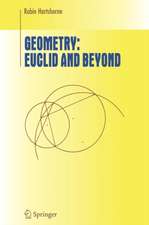Symmetry in Finite Generalized Quadrangles: Frontiers in Mathematics
Autor Koen Thasen Limba Engleză Paperback – 26 ian 2004
Din seria Frontiers in Mathematics
-
 Preț: 491.98 lei
Preț: 491.98 lei -
 Preț: 397.68 lei
Preț: 397.68 lei -
 Preț: 399.60 lei
Preț: 399.60 lei - 15%
 Preț: 490.14 lei
Preț: 490.14 lei -
 Preț: 400.71 lei
Preț: 400.71 lei -
 Preț: 398.72 lei
Preț: 398.72 lei -
 Preț: 416.38 lei
Preț: 416.38 lei -
 Preț: 402.16 lei
Preț: 402.16 lei -
 Preț: 396.64 lei
Preț: 396.64 lei - 15%
 Preț: 649.77 lei
Preț: 649.77 lei -
 Preț: 485.18 lei
Preț: 485.18 lei -
 Preț: 417.30 lei
Preț: 417.30 lei - 15%
 Preț: 703.85 lei
Preț: 703.85 lei -
 Preț: 420.02 lei
Preț: 420.02 lei -
 Preț: 449.35 lei
Preț: 449.35 lei -
 Preț: 426.72 lei
Preț: 426.72 lei -
 Preț: 422.90 lei
Preț: 422.90 lei -
 Preț: 416.34 lei
Preț: 416.34 lei -
 Preț: 417.30 lei
Preț: 417.30 lei -
 Preț: 414.42 lei
Preț: 414.42 lei -
 Preț: 419.21 lei
Preț: 419.21 lei -
 Preț: 437.34 lei
Preț: 437.34 lei -
 Preț: 417.81 lei
Preț: 417.81 lei -
 Preț: 518.25 lei
Preț: 518.25 lei -
 Preț: 425.08 lei
Preț: 425.08 lei -
 Preț: 482.56 lei
Preț: 482.56 lei -
 Preț: 457.03 lei
Preț: 457.03 lei - 15%
 Preț: 704.17 lei
Preț: 704.17 lei -
 Preț: 448.38 lei
Preț: 448.38 lei -
 Preț: 419.59 lei
Preț: 419.59 lei -
 Preț: 514.00 lei
Preț: 514.00 lei -
 Preț: 432.51 lei
Preț: 432.51 lei -
 Preț: 426.34 lei
Preț: 426.34 lei -
 Preț: 419.43 lei
Preț: 419.43 lei -
 Preț: 487.37 lei
Preț: 487.37 lei -
 Preț: 415.39 lei
Preț: 415.39 lei -
 Preț: 427.33 lei
Preț: 427.33 lei -
 Preț: 276.84 lei
Preț: 276.84 lei -
 Preț: 422.90 lei
Preț: 422.90 lei -
 Preț: 459.92 lei
Preț: 459.92 lei -
 Preț: 422.90 lei
Preț: 422.90 lei -
 Preț: 422.90 lei
Preț: 422.90 lei -
 Preț: 416.54 lei
Preț: 416.54 lei -
 Preț: 424.22 lei
Preț: 424.22 lei -
 Preț: 420.02 lei
Preț: 420.02 lei -
 Preț: 419.59 lei
Preț: 419.59 lei -
 Preț: 467.64 lei
Preț: 467.64 lei -
 Preț: 496.72 lei
Preț: 496.72 lei -
 Preț: 422.11 lei
Preț: 422.11 lei
Preț: 423.29 lei
Nou
Puncte Express: 635
Preț estimativ în valută:
80.100€ • 84.40$ • 67.06£
80.100€ • 84.40$ • 67.06£
Carte tipărită la comandă
Livrare economică 03-17 aprilie
Preluare comenzi: 021 569.72.76
Specificații
ISBN-13: 9783764361587
ISBN-10: 3764361581
Pagini: 240
Ilustrații: XXI, 214 p.
Dimensiuni: 178 x 254 x 13 mm
Greutate: 0.46 kg
Ediția:2004
Editura: Birkhäuser Basel
Colecția Birkhäuser
Seria Frontiers in Mathematics
Locul publicării:Basel, Switzerland
ISBN-10: 3764361581
Pagini: 240
Ilustrații: XXI, 214 p.
Dimensiuni: 178 x 254 x 13 mm
Greutate: 0.46 kg
Ediția:2004
Editura: Birkhäuser Basel
Colecția Birkhäuser
Seria Frontiers in Mathematics
Locul publicării:Basel, Switzerland
Public țintă
ResearchCuprins
Introduction: History, Motivation.- 1. Finite Generalized Quadrangles.- 2. Elation Generalized Quadrangles, Translation Generalized Quadrangles and Flocks.- 3. The Known Generalized Quadrangles.- 4. Substructures of Finite Nets.- 5. Symmetry Class I: Generalized Quadrangles with Axes of Symmetry.- 6. Symmetry Class II: Concurrent Axes of Symmetry in Generalized Quadrangles.- 7. Symmetry Class II: Span-Symmetric Generalized Quadrangles.- 8. Generalized Quadrangles with Distinct Translation Points.- 9. The Classification Theorem.- 10. Symmetry Class IV.3: TGQs which Arise from Flocks .- 11. A Characterization Theorem and a Classification Theorem.- 12. Symmetry Class V.- 13. Recapitulation of the Classification Theorem.- 14. Semi Quadrangles.- Appendices.- References.
Caracteristici
Contains many new results, not previously published anywhere else Proof of the main (classification) result is written and split up in such a way that many parts of it can be seen in their own right, and can be used independently Several open problems and longstanding conjectures are completely solved in the book, often by introducing new techniques which can be used in various other situations














